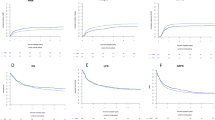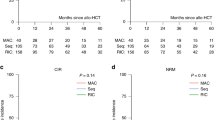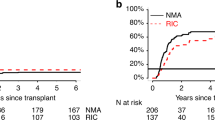Abstract
Limited therapeutic options are available after relapse of acute leukaemia following first reduced intensity conditioning haematopoietic stem cell transplantation (RIC1). A retrospective study on European Society for Blood and Marrow Transplantation (EBMT) registry data was performed on 234 adult patients with acute leukaemia who received a second RIC transplantation (RIC2) from 2000 to 2012 as a salvage treatment for relapse following RIC1. At the time of RIC2, 167 patients (71.4%) had relapsed or refractory disease, 49 (20.9%) were in second CR and 18 (7.7%) in third or higher CR. With a median follow-up of 21 (1.5–79) months after RIC2, 51 patients are still alive. At 2 years, the cumulative incidence of non-relapse mortality (NRM), relapse incidence (RI), leukaemia-free survival (LFS) and overall survival (OS) were 22.4% (95% confidence interval (CI): 17–28.4), 63.9% (56.7–70.1), 14.6% (8.8–18.5) and 20.5% (14.9–26.1), respectively. In patients with acute myelogenous, biphenotypic and undifferentiated leukaemia (representing 89.8% of all patients), duration of remission following RIC1 >225 days, presence of CR at RIC2, patient’s Karnofsky performance status >80 at RIC2 and non-myeloablative conditioning were found to be the strongest predictors of patients’ favourable outcome.
This is a preview of subscription content, access via your institution
Access options
Subscribe to this journal
Receive 12 print issues and online access
$259.00 per year
only $21.58 per issue
Buy this article
- Purchase on Springer Link
- Instant access to full article PDF
Prices may be subject to local taxes which are calculated during checkout


Similar content being viewed by others
References
Porter DL, Alyea EP, Alyea JH, DeLima M, Estey E, Falkenburg JH et al. NCI First International Workshop on the Biology, Prevention, and Treatment of Relapse after Allogeneic Hematopoietic Stem Cell Transplantation: Report from the Committee on Treatment of Relapse after Allogeneic Hematopoietic Stem Cell Transplantation. Biol Blood Marrow Transplant 2010; 16: 1467–1503.
Pollyea DA, Artz AS, Stock W, Daugherty C, Godley L, Odenike OM et al. Outcomes of patients with AML and MDS who relapse or progress after reduced intensity allogeneic hematopoietic cell transplantation. Bone Marrow Transplant 2007; 40: 1027–1032.
Schmid C, Labopin M, Nagler A, Niederwieser D, Castagna L, Tabrizi R et al. Treatment, risk factors, and outcome of adults with relapsed AML after reduced intensity conditioning for allogeneic stem cell transplantation. Blood 2012; 119: 1599–1606.
Mielcarek M, Storer BE, Flowers ME, Storb R, Sandmaier BM, Martin PJ . Outcomes among patients with recurrent high-risk hematologic malignancies after allogeneic hematopoietic cell transplantation. Biol Blood Marrow Transplant 2007; 13: 1160–1168.
Weisdorf D, Zhang MJ, Arora M, Horowitz MM, Rizzo JD, Eapen M . Graft-versus-host disease induced graft-versus-leukemia effect: greater impact on relapse and disease-free survival after reduced intensity conditioning. Biol Blood Marrow Transplant 2012; 18: 1727–1733.
Foran JM, Pavletic SZ, Logan BR, Agovi-Johnson MA, Pérez WS, Bolwell BJ et al. Unrelated donor allogeneic transplantation after failure of autologous transplantation for acute myelogenous leukemia: a study from the center for international blood and marrow transplantation research. Biol Blood Marrow Transplant 2013; 19: 1102–1108.
Hong JY, Choi MK, Kim DH, Kim SJ, Kim K, Kim WS et al. Feasibility of second hematopoietic stem cell transplantation using reduced-intensity conditioning with fludarabine and melphalan after a failed autologous hematopoietic stem cell transplantation. Transplant Proc 2010; 42: 3723–3728.
Shaw BE, Mufti GJ, Mackinnon S, Cavenagh JD, Pearce RM, Towlson KE et al. Outcome of second allogeneic transplants using reduced-intensity conditioning following relapse of haematological malignancy after an initial allogeneic transplant. Bone Marrow Transplant 2008; 42: 783–789.
Kaplan EL, Meier P . Nonparametric estimation from incomplete observations. J Am Stat Assoc 1958; 53: 457–481.
Gooley TA, Leisenring W, Crowley J, Storer BE . Estimation of failure probabilities in the presence of competing risks: new representations of old estimators. Stat Med 1999; 18: 695–706.
Glucksberg H, Storb R, Fefer A, Buckner CD, Neiman PE, Clift RA et al. Clinical manifestations of graft-versus-host disease in human recipients of marrow from HLA-matched sibling donors. Transplantation 1974; 18: 295–304.
Shulman H, Sullivan KM, Weiden PL, McDonald GB, Striker GE, Sale GE et al. Chronic graft-versus-host syndrome in man. A long-term clinicopathologic study of 20 Seattle patients. Am J Med 1980; 69: 204–217.
Andersen PK, Gill RD . Cox’s Regression Model for Counting Processes: A Large Sample Study. Ann Statist 1982; 10: 1100–1120.
Therneau TM, Grambsch PM . Modeling Survival Data: Extending the Cox Model. Statistics for Biology and Health. Springer Science+Business Media: : New York, NY, USA, 2000.
Simon R, Makuch RW . A non-parametric graphical representation of the relationship between survival and the occurrence of an event: application to responder versus non-responder bias. Stat Med 1984; 3: 35–44.
Cox DR . Regression models and life-tables. J R Stat Assoc 1972; 34: 187–220.
Abdul Wahid SF, Ismail NA, Mohd-Idris MR, Jamaluddin FW, Tumian N, Sze-Wei EY et al. Comparison of reduced-intensity and myeloablative conditioning regimens for allogeneic hematopoietic stem cell transplantation in patients with acute myeloid leukemia and acute lymphoblastic leukemia: a meta-analysis. Stem Cells Dev 2014; 23: 2535–2552.
Alyea EP, Kim HT, Ho V, Cutler C, DeAngelo DJ, Stone R et al. Impact of conditioning regimen intensity on outcome of allogeneic hematopoietic cell transplantation for advanced acute myelogenous leukemia and myelodysplastic syndrome. Biol Blood Marrow Transplant 2006; 12: 1047–1055.
Aoudjhane M, Labopin M, Gorin N, Shimoni A, Ruutu T, Kolb HJ et al. Comparative outcome of reduced intensity and myeloablative conditioning regimen in HLA identical sibling allogeneic haematopoietic stem cell transplantation for patients older than 50 years of age with acute myeloblastic leukaemia: a retrospective survey from the Acute Leukaemia Working Party (ALWP) of the European group for Blood and Marrow Transplantation (EBMT). Leukemia 2005; 19: 2304–2312.
Munoz A, Badell I, Olive T, Verdeguer A, Gomez P, Bureo E . Second allogeneic hematopoietic stem cell transplantation in hematologic malignancies in children: long-term results of a multicenter study of the Spanish Working Party for Bone Marrow Transplantation in Children (GETMON). Haematologica 2002; 87: 331–332.
Bosi A, Laszlo D, Labopin M, Reffeirs J, Michallet M, Gluckman E et al. Second allogeneic bone marrow transplantation in acute leukemia: results of a survey by the European cooperative group for blood and marrow transplantation. J Clin Oncol 2001; 19: 3675–3684.
Wolff SN . Second hematopoietic stem cell transplantation for the treatment of graft failure, graft rejection or relapse after allogeneic transplantation. Bone Marrow Transplant 2002; 29: 545–552.
Michallet M, Tanguy ML, Socie G, Thie´baut A, Belhabri A, Milpied N et al. Second allogeneic haematopoietic stem cell transplantation in relapsed acute and chronic leukaemias for patients who underwent a first allogeneic bone marrow transplantation: a survey of the Societe Francaise de Greffe de moelle (SFGM). Br J Haematol 2000; 108: 400–407.
Bosi A, Bacci S, Miniero R, Locatelli F, Laszlo D, Longo G et al. Second allogeneic bone marrow transplantation in acute leukemia: a multicenter study from the gruppo italiano trapianto di midollo osseo (GITMO). Leukemia 1997; 11: 420–424.
Christopoulos P, Schmoor C, Waterhouse M, Marks R, Wasch R, Bertz H et al. Reduced-intensity conditioning with fludarabine and thiotepa for second allogeneic transplantation of relapsed patients with AML. Bone Marrow Transplant 2013; 48: 901–907.
Christopeit M, Kuss O, Finke J, Bacher U, Beelen DW, Bornhauser M et al. Second allograt for hematologic relapse of acute leukemia after first allogeneic stem-cell transplantation from related and unrelated donors: the role of donor change. J Clin Oncol 2013; 31: 3259–3271.
Radich JP, Sanders JE, Buckner CD, Martin PJ, Petersen FB, Bensinger W et al. Second allogeneic marrow transplantation for patients with recurrent leukemia after initial transplant with total-body irradiation-containing regimens. J Clin Oncol 1993; 11: 304–313.
Eapen M, Giralt SA, Horowitz MM, Klein JP, Wagner JE, Zhang MJ et al. Second transplant for acute and chronic leukemia relapsing after first HLA-identical sibling transplant. Bone Marrow Transplant 2004; 34: 721–727.
Pawson R, Potter MN, Theocharous P, Lawler M, Garg M, Yin JA et al. Treatment of relapse after allogeneic bone marrow transplantation with reduced intensity conditioning (FLAG +/Ida) and second allogeneic stem cell transplant. Br J Haematol 2001; 115: 622–629.
Sica RA, Vosganian GS, Tuscano JM, Law LY, Richman CM . Reduced intensity stem cell transplant (RIST) as salvage treatment for relapse following myeloablative allogeneic transplantation in adult acute myeloid leukemia. Biol Blood Marrow Transplant 2007; 13 (Suppl 2) 133 (abstract 367).
Kishi K, Takahashi S, Gondo H, Shiobara S, Kanamaru A, Kato S et al. Second allogeneic bone marrow transplantation for post-transplant leukemia relapse: results of a survey of 66 cases in 24 Japanese institutes. Bone Marrow Transplant 1997; 19: 461–466.
Levine JE, Braun T, Penza SL, Beatty P, Cornetta K, Martino R et al. Prospective trial of chemotherapy and donor leukocyte infusions for relapse of advanced myeloid malignancies after allogeneic stem-cell transplantation. J Clin Oncol 2002; 20: 405–412.
Schmid C, Labopin M, Nagler A, Bornhauser M, Finke J, Fassas A et al. Donor lymphocyte infusion in the treatment of first hematological relapse after allogeneic stem-cell transplantation in adults with acute myeloid leukemia: a retrospective risk factors analysis and comparison with other strategies by the EBMT Acute Leukemia Working Party. J Clin Oncol 2007; 25: 4938–4945.
Oran B, Giralt S, Couriel D, Hosing C, Shpall EJ, de Meis E et al. Treatment of AML and MDS relapsing after reduced-intensity conditioning and allogeneic hematopoietic stem cell transplantation. Leukemia 2007; 21: 2540–2544.
Mrsic M, Horowitz MM, Atkinson K, Biggs JC, Champlin RE, Ehninger G et al. Second HLA-identical sibling transplants for leukemia recurrence. Bone Marrow Transplant 1992; 9: 269–275.
Kedmi M, Resnick IB, Dray L, Aker M, Samuel S, Gesundheit B et al. A retrospective review of the outcome after second or subsequent allogeneic transplantation. Biol Blood Marrow Transplant 2009; 15: 483–489.
Hosing C, Saliba RM, Shahjahan M, Estey EH, Couriel D, Giralt S et al. Disease burden may identify patients more likely to benefit from second allogeneic hematopoietic stem cell transplantation to treat relapsed acute myelogenous leukemia. Bone Marrow Transplant 2005; 36: 157–162.
Mielke S, Barrett AJ. Management of relapse and minimal residual disease after stem cell transplantation. In: Treleaven J, Barrett AJ (eds). Hematopoietic Stem Cell Transplantation in Clinical Practice. Churchill Livingstone Elsevier: : London, UK; New York, NY, USA, 2009, pp 409–416.
Acknowledgements
MM would like to thank Pr JV de Melo (University of Adelaide, Australia) for critical reading of the manuscript.
Author information
Authors and Affiliations
Consortia
Corresponding author
Ethics declarations
Competing interests
The authors declare no conflict of interest.
Rights and permissions
About this article
Cite this article
Vrhovac, R., Labopin, M., Ciceri, F. et al. Second reduced intensity conditioning allogeneic transplant as a rescue strategy for acute leukaemia patients who relapse after an initial RIC allogeneic transplantation: analysis of risk factors and treatment outcomes. Bone Marrow Transplant 51, 186–193 (2016). https://doi.org/10.1038/bmt.2015.221
Received:
Revised:
Accepted:
Published:
Issue Date:
DOI: https://doi.org/10.1038/bmt.2015.221
This article is cited by
-
Outcomes of third allogeneic hematopoietic stem cell transplantation in relapsed/refractory acute leukemia after a second transplantation
Bone Marrow Transplantation (2022)
-
Impact of conditioning regimen intensity on outcomes of second allogeneic hematopoietic cell transplantation for secondary acute myelogenous leukemia
Bone Marrow Transplantation (2022)
-
Outcomes of pediatric patients who relapse after first HCT for acute leukemia or MDS
Bone Marrow Transplantation (2021)
-
Allogeneic hematopoietic stem cell transplantation from a 2-HLA-haplotype-mismatched family donor for posttransplant relapse: a prospective phase I/II study
Bone Marrow Transplantation (2021)
-
Second unmanipulated allogeneic transplantation could be used as a salvage option for patients with relapsed acute leukemia post-chemotherapy plus modified donor lymphocyte infusion
Frontiers of Medicine (2021)



